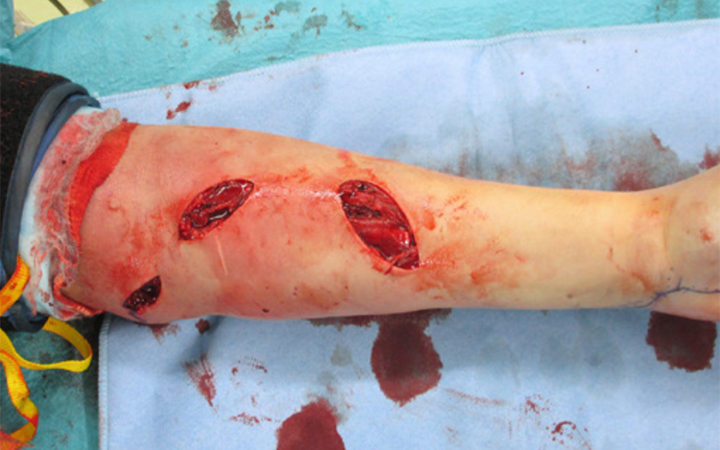Deadly Pressure: Why These Two Men's Muscles 'Blew Up' From the Inside

The medical condition known as acute compartment syndrome (ACS) doesn't sound especially dramatic, but its consequences can be gruesome and potentially lethal; it causes swift and extreme muscle swelling that can require slicing through the skin and muscle wall to relieve the pressure.
The condition is usually associated with a highly traumatic injury, but for two people in Japan, doctors traced ACS to an unlikely source — bites from a venomous snake, according to a new report of the two cases.
The two cases happened eight years apart — in 2008 and 2016 — and the people didn't know each other, according to the report, published April 1 in the journal BMJ Case Reports. In both instances, the patients had massively swollen extremities, and were separately diagnosed with ACS, but neither showed signs of severe trauma. [27 Oddest Medical Cases]
After treating them, doctors concluded that in both cases, the extraordinary localized swelling was a reaction to a bite from a type of viper known as the mamushi, which is native to Japan and other parts of Asia.
Under pressure
ACS is an exceptionally painful condition affecting groupings of muscles, blood vessels and nerves in the arms and legs that are known as compartments, which are bound together by a robust membrane called the fascia, according to the American Academy of Orthopaedic Surgeons (AAOS).
During ACS, pressure swiftly builds up inside the muscle compartment, blocking the flow of blood to and from the damaged site, said Dr. Sanjit Konda, an assistant professor of orthopedic surgery at NYU Langone Health in New York City.
"The pressure becomes so great in the compartment that the muscle and all of the other tissue is not getting any nutrients, and is going to start dying," said Konda, who was not involved in the case report. In urgent ACS cases, irreversible muscle damage can occur within 4 to 12 hours, and so surgeons must relieve the loss of circulation and prevent tissue death with a technique known as fasciotomy, a procedure that slices through the fascia, according to the case report authors.
Get the world’s most fascinating discoveries delivered straight to your inbox.
Typically, ACS is caused by a severe, high-impact injury — "usually a crush injury," such as a car or motorcycle accident, or a trauma involving heavy machinery, Konda told Live Science. However, ACS can also develop from a minor trauma in people who are on blood-thinning medication, or it can emerge following the injection of a foreign material into the arm or leg, such as snake venom, he explained.
Two mysterious cases
In one of the cases described in the report, a 38-year-old man was hospitalized in 2016 with a dramatic swelling from his forearm to his shoulder. In the earlier case, from 2008, the report described a 42-year-old man who developed swelling throughout his right leg and foot. In both instances, the painful swelling was so severe that the surgeons had to make cuts to the limbs, to relieve the pressure and prevent permanent muscle damage.
Neither patient had recently experienced a severe trauma that could explain his ACS, which puzzled the doctors. But they noted that the patients could also have been having a reaction to the venom of a snake or an insect. The time of year and locations where the injuries occurred, along with the rapid emergence of the swelling, suggested to the doctors that a type of snake in the viper family commonly known as the mamushi (Gloydius blomhoffii) was the culprit.
The mamushi is widespread in Japan, Korea and parts of China and Russia, according to a reptile database maintained by the Zoological Museum at the University of Hamburg in Germany. They hide under grasses and leaves and can be tough to spot, as they measure less than 24 inches (60 centimeters) in length. And their bites, delivered with delicate fangs that measure about 0.2 inches (5 millimeters) long, initially cause only minor pain and leave marks that are often too small to see, according to the case report.
A toxic attack
However, mamushi venom is powerful, and is so renowned that it was included in an ancient Japanese samurai scroll of deadly battle tactics. The powdered venom, when mixed with other ingredients and blown into an enemy's face, was said to be capable of rendering them unconscious, though it "has not been fully tested," according to the text.
After a bite, toxins in the venom could have made their way into a capillary and ruptured it, causing a leak that would have led to a buildup of extreme pressure, the study authors reported.
Venomous bites can also lead to ACS because they can trigger significant inflammation around the area where the venom was injected, and chemicals in the venom may hinder blood clotting, "which can cause you to bleed more," Konda said.
Although the study authors concluded that mamushi bites were the most plausible explanation for the patients' ACS, the "diagnosis could not be established owing to the lack of bite marks and clinical history of bite," and so they administered no antivenom, they wrote in the report.
Luckily, the swift actions of the medical teams in the study enabled both ACS patients to recover. The man with the swollen arm was discharged after 32 days, with normal function of his arm and hand restored. And though the patient with the swollen leg left the hospital with his injured limb paralyzed, he fully regained use of the leg after two years, the study authors reported.
Original article on Live Science.

Mindy Weisberger is a science journalist and author of "Rise of the Zombie Bugs: The Surprising Science of Parasitic Mind-Control" (Hopkins Press). She formerly edited for Scholastic and was a channel editor and senior writer for Live Science. She has reported on general science, covering climate change, paleontology, biology and space. Mindy studied film at Columbia University; prior to LS, she produced, wrote and directed media for the American Museum of Natural History in NYC. Her videos about dinosaurs, astrophysics, biodiversity and evolution appear in museums and science centers worldwide, earning awards such as the CINE Golden Eagle and the Communicator Award of Excellence. Her writing has also appeared in Scientific American, The Washington Post, How It Works Magazine and CNN.



